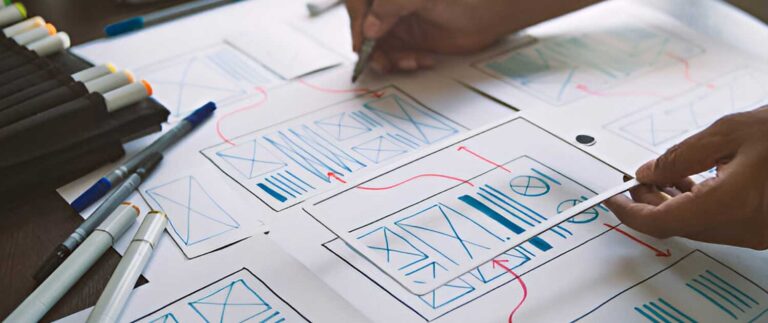UI/UX Design Basics
In the world of digital design, the terms “UI” and “UX” are often used interchangeably. However, they refer to two distinct aspects of the design process, each playing a critical role in creating user-friendly and effective digital products. Understanding the basics of UI/UX design is crucial for anyone involved in the design, development, or marketing of digital products. In this post, we’ll dive deep into the basics of UI/UX design, define UX design, and explain the difference between UI and UX design.
What is UI/UX Design?
UI/UX design stands for User Interface (UI) and User Experience (UX) design. While they are often grouped together, they focus on different elements of the digital design process. UI design is concerned with the visual aspects of a product, such as buttons, icons, and layout. UX design, on the other hand, focuses on the overall experience a user has with the product, including how easy and satisfying it is to use.
Define UX Design
UX design, or User Experience design, is the process of creating products that provide meaningful and relevant experiences to users. This involves a deep understanding of users, their needs, values, abilities, and limitations. The goal of UX design is to create a product that is easy to use, efficient, and enjoyable, ensuring that users can accomplish their goals without frustration.
The Basics of UX Design
- User Research: The foundation of UX design is understanding the user. This involves conducting research to gather insights into user behaviors, needs, and motivations. Common methods include interviews, surveys, and usability testing.
- Information Architecture: Information architecture is about organizing and structuring content in a way that users can easily navigate and find what they need. A well-organized site or app makes for a smoother and more intuitive user experience.
- Wireframing and Prototyping: Wireframes are simple, black-and-white layouts that outline the structure and functionality of a product. Prototypes are more advanced, interactive models that allow designers to test and refine their ideas before full-scale development.
- Usability Testing: Usability testing involves observing real users as they interact with the product to identify any issues or areas for improvement. This is a crucial step in ensuring that the product is user-friendly and effective.
- Iteration: UX design is an iterative process, meaning it involves continuous testing, feedback, and refinement. Even after a product is launched, it’s important to keep improving the user experience based on user feedback and data.
Understanding UI Design
While UX design is about the overall experience, UI design focuses on the product’s interface – the point of interaction between the user and the product. UI design is concerned with how the product looks and feels, including the layout, color schemes, typography, and interactive elements like buttons and menus.
The Basics of UI Design
- Visual Design: Visual design is the aesthetic aspect of UI design. It involves choosing color schemes, fonts, and other visual elements that align with the brand and appeal to users.
- Typography: Typography is a crucial aspect of UI design, as it affects readability and the overall visual hierarchy of the interface. Choosing the right fonts and font sizes is essential for creating a clear and user-friendly interface.
- Layout and Grid Systems: A well-organized layout helps guide users through the interface, making it easier for them to find what they need. Grid systems are often used to create a consistent and balanced layout.
- Interactive Elements: Buttons, menus, sliders, and other interactive elements are key components of UI design. These elements need to be intuitive and easy to use, helping users navigate the product effortlessly.
- Consistency: Consistency is a crucial principle in UI design. Using consistent visual elements and interaction patterns across the product helps users learn how to use the interface quickly and reduces confusion.
Difference Between UI and UX Design
While UI and UX design are closely related, they serve different purposes in the design process. Here’s a breakdown of the key differences:
- Focus: UX design focuses on the overall experience of the user, ensuring the product is easy to use, efficient, and enjoyable. UI design focuses on the visual and interactive aspects of the product, creating a visually appealing and intuitive interface.
- Process: UX design involves user research, information architecture, wireframing, prototyping, and usability testing. UI design involves visual design, typography, layout, and creating interactive elements.
- Outcome: The outcome of UX design is a product that meets user needs and provides a positive experience. The outcome of UI design is a visually appealing and user-friendly interface.
Why UI/UX Design Matters
In today’s competitive digital landscape, UI/UX design is more important than ever. A well-designed product can set a brand apart from its competitors and create loyal customers. Conversely, a poorly designed product can frustrate users and drive them away.
The Impact of UX Design
A positive user experience can lead to higher user satisfaction, increased engagement, and better conversion rates. By focusing on the needs and goals of the user, UX design helps create products that are not only functional but also enjoyable to use.
The Role of UI Design
UI design plays a crucial role in shaping the user’s first impression of a product. A visually appealing and intuitive interface can attract users and encourage them to explore the product further. On the other hand, a cluttered or confusing interface can turn users away before they even get a chance to experience the product’s full potential.
An enjoyable experience for users
UI/UX design is a critical aspect of creating successful digital products. By understanding the basics of UI/UX design, you can create products that not only look great but also provide a seamless and enjoyable experience for users. Whether you’re a designer, developer, or marketer, a solid understanding of UI/UX design can help you create products that meet the needs of your users and stand out in a crowded market.
By focusing on both the user experience and the user interface, you can create products that are not only functional but also delightful to use. Remember, a great product is one that not only meets the needs of its users but also exceeds their expectations.

Experto en Web Marketing con más de 15 años de experiencia en diferentes disciplinas como Diseñador UX/ UI, Web Developer, Branding, Ilustración, entre otras. Saber más de mí
Si tienes proyectos interesantes enviame un mensaje.






